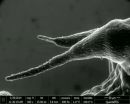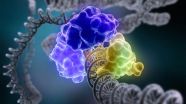(Press-News.org) WASHINGTON D.C., March 30, 2015 - Plants living in arid, mountainous and humid regions of the planet often rely on their leaves to obtain the moisture they need for survival by pulling mist out of the air. But how exactly they manage this feat has been a bit of a mystery--until now.
By studying the morphology and physiology of plants with tiny conical "hairs" or microfibers on the surface of their leaves, such as tomatoes, balsam pears and the flowers Berkheya purpea and Lychnis sieboldii, a team of researchers in Japan uncovered water collection-and-release secrets that may, in turn, one day soon "bioinspire" a technology to pull fresh water from the air to help alleviate global water shortages.
As the team reports in a story appearing on this week's cover of the journal Applied Physics Letters, from AIP Publishing, they examined Lychnis sieboldii in detail and discovered a unique water collection-and-release feature: cone-shaped hairs with inner microfibers reversibly transform to crushed plates that "twist" perpendicularly in dry conditions.
"We zeroed in on the microstructure of the plants via advanced electron microscope technology and recorded the dynamic changes involved in the water collection process in the form of a movie," explained Professor Shigeru Yamanaka, who is on the Faculty of Textile Science and Technology at Shinshu University.
What did this reveal? Microfibers found within the hairs appear to be responsible for both water storage and release. Depending on the moisture level in the air, when needed, water stored during wet conditions gets released onto the leaf in dry conditions.
At room temperature, Lychnis sieboldii hairs showed changes in their morphology depending on exposure to water. In a wet state, the hairs became cone-shaped immediately after a water droplet adhered to it. After drying, the cone shapes morphed into a perpendicularly twisted structure at a 90° angle. But when a droplet of water was placed on the hairs they reverted back to their initial cone shape, which may be a "shape memory" effect.
The team tapped simulations to help explain the formation of the twisted structure, which they believe "adds increased mechanical strength to the hairs." Similar phenomena were found in the other plants with "hairy" leaves.
"Under dry conditions, the hairs also twisted in a similar manner," said Yamanaka. "They converted to a cone shape, just like Lychnis sieboldii, when exposed to water droplets--suggesting that this strategy of water control is common among plants with similar hairs on their leaves' surfaces."
How might these findings one day help alleviate the world's water shortage? "These plants give us great ideas worth mimicking," noted Yamanaka. "Advanced fiber technology can be used to 'replicate' the plant hair's fiber 'net structure' and enable the development of an apparatus capable of collecting water from the air in arid regions of the world."
INFORMATION:
The article, "Mechanics of Water Collection in Plants via Morphology Change of Conical Hairs," is authored by Fuya Ito, Satoshi Komatsubara, Naoki Shigezawa, Hideaki Morikawa, Yasushi Murakami, Katsumi Yoshino and Shigeru Yamanaka. It appears in the journal Applied Physics Letters on March 30, 2015 (DOI: 10.1063/1.4916213). After that date, it can be accessed at: http://scitation.aip.org/content/aip/journal/apl/106/13/10.1063/1.4916213
Authors of this study are affiliated with Shinshu University and the Shimane Institute for Industrial Technology.
ABOUT THE JOURNAL
Applied Physics Letters features concise, rapid reports on significant new findings in applied physics. The journal covers new experimental and theoretical research on applications of physics phenomena related to all branches of science, engineering, and modern technology. See: http://apl.aip.org
Cholesterol-lowering statins have transformed the treatment of heart disease. But while the decision to use the drugs in patients with a history of heart attacks and strokes is mostly clear-cut, that choice can be a far trickier proposition for the tens of millions of Americans with high cholesterol but no overt disease.
Now a report from preventive cardiologists at Johns Hopkins and elsewhere offers a set of useful tips for physicians to help their patients make the right call.
The report, published March 30 in the Journal of the American College of Cardiology, combines ...
TORONTO, March 30, 2015 - In their latest brain imaging study on women at risk for Alzheimer's disease, York University researchers have found deterioration in the pathways that serve to communicate signals between different brain regions needed for performing everyday activities such as driving a car or using a computer.
"We observed a relationship between the levels of deterioration in the brain wiring and their performance on our task that required simultaneous thinking and moving; what we see here is a result of communication failure," explains Professor Lauren Sergio ...
SAN ANTONIO, Texas, U.S.A. (March 30, 2015) -- Patients with chronic kidney disease may be treated with a class of medications called Renin Angiotensin Aldosterone System inhibitors (RAASI's). Although these drugs protect the heart and kidney, a significant percentage of patients develop a dangerous side effect -- high potassium levels in the blood (hyperkalemia).
Elevated potassium puts patients at risk of death from cardiac arrhythmias. Lacking a drug to treat the problem, doctors either stop these beneficial drugs or may use kidney dialysis to quickly lower the potassium.
At ...
If a lump is found in the breast of an adolescent girl, she often will undergo an excisional biopsy. However, breast cancer is rare in adolescents, and the vast majority of teenage breast lumps turn out to be benign masses that are related to hormones and often go away over time.
A recent Loyola University Health System study published in the Journal of Ultrasound in Medicine suggests that a breast ultrasound examination might eliminate the need for biopsy in many cases.
Loyola radiologists studied 37 teen girls with a total of 45 breast lumps to determine whether ...
The DNA molecule is chemically unstable giving rise to DNA lesions of different nature. That is why DNA damage detection, signaling and repair, collectively known as the DNA damage response, are needed. The DNA damage response is immensely important, for example, for ensuring the highest possible quality of the DNA before replication - duplication of the DNA prior to cell division. If the damaged DNA is replicated, the risk of cancer and other diseases increases significantly due to mutations. All in all this may lead to the death of a cell itself.
DNA repair consists ...
Fasting in combination with chemotherapy has already been shown to kill cancer cells, but a pair of new studies in mice suggests that a less-toxic class of drugs combined with fasting may kill breast, colorectal and lung cancer cells equally well.
If shown to work in humans, this combination could replace chemotherapy and make fasting a potent component of a long-term strategy to treat cancer, according to senior author Valter Longo of USC.
Human clinical trials in the United States and Europe are already studying the effectiveness and safety of Longo's strategy of ...
TORONTO, March 30, 2015 - In their latest brain imaging study on women at risk for Alzheimer's disease, York University researchers have found deterioration in the pathways that serve to communicate signals between different brain regions needed for performing everyday activities such as driving a car or using a computer.
"We observed a relationship between the levels of deterioration in the brain wiring and their performance on our task that required simultaneous thinking and moving; what we see here is a result of communication failure," explains Professor Lauren Sergio ...
March 30, 2015 - New estimates suggest that 20 to 30 percent of opioid analgesic drugs prescribed for chronic pain are misused, while the rate of opioid addiction is approximately 10 percent, reports a study in the April issue of END ...
New guidelines from the Canadian Task Force on Preventive Health Care to help prevent and manage obesity in children and youth recommend regular growth monitoring at routine health care visits as well as a focus on family lifestyles and health behaviours. The guidelines, published in CMAJ (Canadian Medical Association Journal), are aimed at helping primary care practitioners address this major public health issue.
Growth monitoring includes measuring weight, height or length, calculating body mass index and plotting these according to age using the measures on the WHO ...
SAN FRANCISCO--Located in the Marmara Sea, major earthquakes along the North Anatolian Fault (NAF) system have repeatedly struck what is current-day Istanbul and the surrounding region, but determining the recurrence rate has proven difficult since the faults are offshore. Cores of marine sediment reveal an earthquake history of the Cinarcik Segment, a main branch of NAF, and suggest a seismic gap where the next earthquake is likely to rupture, as detailed in a new study published in the Bulletin of the Seismological Society of America (BSSA).
The area has experienced ...



